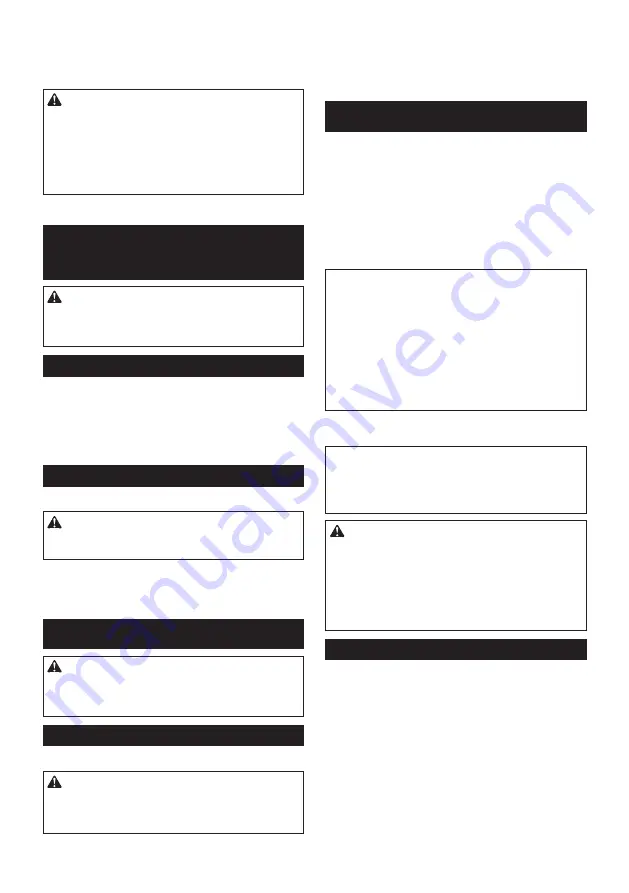
9 ENGLISH
18.
Always use the correct dust mask/respirator
for the material and application you are work
-
ing with.
SAVE THESE INSTRUCTIONS.
WARNING:
DO NOT let comfort or famil
-
iarity with product (gained from repeated
use) replace strict adherence to safety
rules for the subject product. MISUSE or
failure to follow the safety rules stated in
this instruction manual may cause serious
personal injury.
FUNCTIONAL
DESCRIPTION
CAUTION:
•
Always be sure that the tool is switched off and
unplugged before adjusting or checking function
on the tool.
Adjusting bit protrusion
►
Fig.1:
1.
Base
2.
Scale
3.
Bit protrusion
4.
Clamping
screw
To adjust the bit protrusion, loosen the clamping screw
and move the tool base up or down as desired. After
adjusting, tighten the clamping screw firmly to secure
the tool base.
Switch action
►
Fig.2:
1.
Switch lever
CAUTION:
•
Before plugging in the tool, always be sure that
the tool is switched off.
To start the tool, move the switch lever to the I position.
To stop the tool, move the switch lever to the O position.
ASSEMBLY
CAUTION:
•
Always be sure that the tool is switched off and
unplugged before carrying out any work on the
tool.
Installing or removing trimmer bit
►
Fig.3:
1.
Loosen
2.
Tighten
3.
Hold
CAUTION:
•
Do not tighten the collet nut without inserting a
bit, or the collet cone will break.
•
Use only the wrenches provided with the tool.
Insert the bit all the way into the collet cone and tighten
the collet nut securely with the two wrenches.
To remove the bit, follow the installation procedure in
reverse.
OPERATION
Set the tool base on the workpiece to be cut without the
bit making any contact. Then turn the tool on and wait
until the bit attains full speed. Move the tool forward
over the workpiece surface, keeping the tool base flush
and advancing smoothly until the cutting is complete.
When doing edge cutting, the workpiece surface should
be on the left side of the bit in the feed direction.
►
Fig.4:
1.
Workpiece
2.
Bit revolving direction
3.
View from the top of the tool
4.
Feed
direction
NOTE:
•
Moving the tool forward too fast may cause
a poor quality of cut, or damage to the bit or
motor. Moving the tool forward too slowly may
burn and mar the cut. The proper feed rate will
depend on the bit size, the kind of workpiece
and depth of cut. Before beginning the cut on
the actual workpiece, it is advisable to make a
sample cut on a piece of scrap lumber. This will
show exactly how the cut will look as well as
enable you to check dimensions.
►
Fig.5:
1.
Feed direction
2.
Bit revolving direction
3.
Workpiece
4.
Straight guide
NOTE:
•
When using the trimmer shoe, the straight guide
or the trimmer guide, be sure to keep it on the
right side in the feed direction. This will help to
keep it flush with the side of the workpiece.
CAUTION:
•
Since excessive cutting may cause overload of
the motor or difficulty in controlling the tool, the
depth of cut should not be more than 3 mm at
a pass when cutting grooves. When you wish
to cut grooves more than 3 mm deep, make
several passes with progressively deeper bit
settings.
Templet guide
►
Fig.6
The templet guide provides a sleeve through which the
bit passes, allowing use of the trimmer with templet
patterns.
Remove the chip deflector.
►
Fig.7:
1.
Screwdriver
2.
Base protector
3.
Screws
Loosen the screws and remove the base protector.
Place the templet guide on the base and replace the
base protector. Then secure the base protector by
tightening the screws.
Secure the templet to the workpiece. Place the tool on
the templet and move the tool with the templet guide
sliding along the side of the templet.
►
Fig.8:
1.
Bit
2.
Base
3.
Templet
4.
Workpiece
5.
Templet guide
Содержание M3701
Страница 3: ...1 2 3 4 1 2 3 4 A 1 2 3 4 5 1 2 3 4 5 1 2 3 Fig 9 Fig 10 Fig 11 Fig 12 Fig 13 Fig 14 Fig 15 Fig 16 3 ...
Страница 4: ...1 2 3 4 5 6 1 2 3 1 1 2 R Fig 17 Fig 18 Fig 19 Fig 20 Fig 21 Fig 22 Fig 23 Fig 24 4 ...
Страница 5: ...Fig 25 Fig 26 Fig 27 Fig 28 Fig 29 Fig 30 Fig 31 Fig 32 5 ...
Страница 6: ...Fig 33 Fig 34 6 ...
























